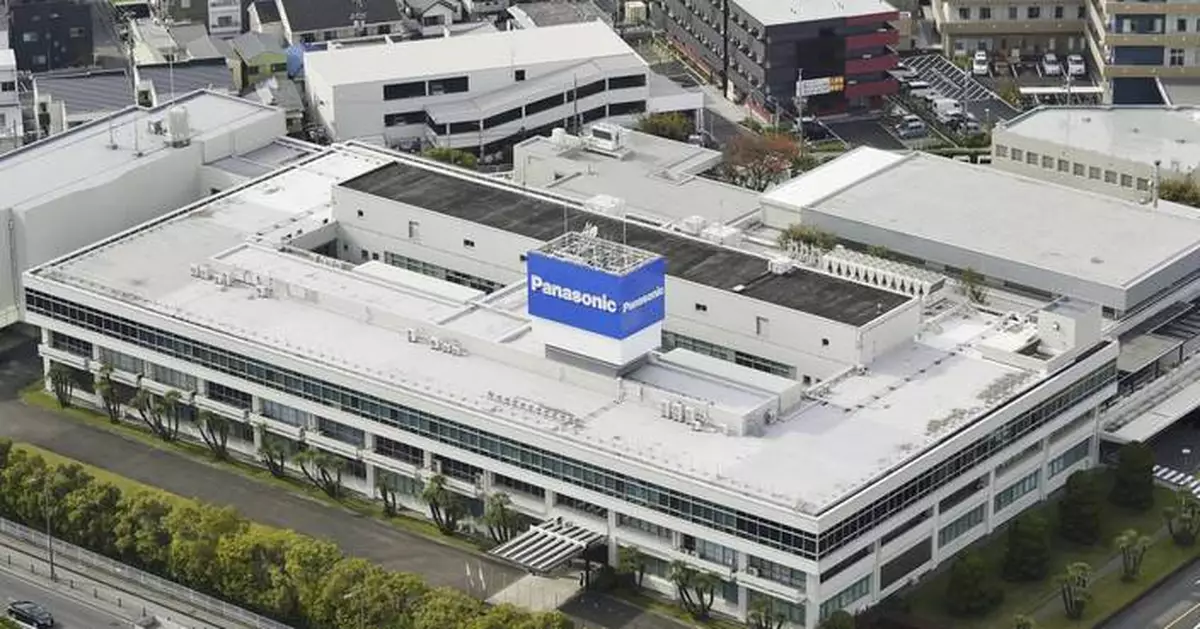TOKYO (AP) — Olympic sponsor Panasonic is terminating its contract with the IOC at the end of the year, the company said in a statement Tuesday.
Panasonic is one of 15 companies that are so-called TOP sponsors for the International Olympic Committee. It's not known the value of the Panasonic sponsorship, but sponsors contribute more than $2 billion in a four-year cycle to the IOC.
In a statement, Panasonic said it became an IOC sponsor in 1987 and expanded to the Paralympics in 2014. It did not make clear why it was changing course and said only that is was related to continual “reviews how sponsorship should evolve.”
Two other Japanese companies are also among the IOC's 15 leading sponsors. Toyota, which for several months has been reportedly ready to end its contract, was contacted Tuesday by The Associated Press but offered no new information.
“Toyota has been supporting the Olympic and Paralympic movements since 2015 and continues to do so,” Toyota said in a statement. “No announcement to suggest otherwise has been made by Toyota."
Japanese sponsors seem to have turned away from the Olympics, likely related to the one-year delay in holding the 2020 Tokyo Olympics. The COVID-19 delay reduced sponsors' visibility with no fans allowed to attend competition venues, ran up the costs, and unearthed myriad corruption scandals around the Games.
Tiremaker Bridgestone told AP “nothing has been decided.”
Toyota had a contact valued at $835 million — reported to be the IOC's largest when it was announced in 2015. It included four Olympics beginning with the Pyeongchang 2018 Winter Games in South Korea and ran through the just-completed Paris Olympics and Paralympics.
Reports in Japan suggest Toyota may keep its Paralympic Olympic sponsorship.
The IOC TOP sponsors are: ABInBev, Airbnb, Alibaba, Allianz, Atos, Bridgestone, Coca-Cola, Deloitte, Intel, Omega, Panasonic, P&G, Samsung, Toyoto, and Visa.
In a report several months ago by the Japanese news agency Kyodo, unnamed sources said Toyota was unhappy with how the IOC uses sponsorship money. It said the money was “not used effectively to support athletes and promote sports.”
Japan was once a major font of revenue, but increasingly the IOC has sought out sponsors from China, with increasing interest from the Middle East and India.
“We would love to welcome a first new TOP sponsor from India and I am sure that this is going to happen very, very soon,” the IOC’s marketing director, Anne-Sophie Voumard, said last month at the Paris Olympics.
“It’s a very, very dynamic program,” Voumard said on Aug. 7 of the TOP slate, adding “partners come and go depending on their business strategy.”
Japan officially spent $13 billion on the Tokyo Olympics, at least half of which was public money. A government audit suggested the real cost was twice that. The IOC contribution was about $1.8 billion.
The Tokyo Games were mired in corruption scandals linked to local sponsorships and the awarding of contracts. Dentsu Inc, the huge Japanese marketing and public relations company, was the marketing arm of the Tokyo Olympics and raised a record-$3.3 billion in local sponsorship money. This is separate from TOP sponsors.
French prosecutors also looked into alleged vote-buying in the IOC’s decision in 2013 to pick Tokyo as the host for the 2020 Summer Games.
The IOC had income of $7.6 billion in the last four-year cycle ending with the Tokyo Games. Figures have not been released yet for the cycle ending with the Paris Olympics.
The IOC’s TOP sponsors paid over $2 billion in that period. The figure is expected to reach $3 billion in the next cycle.
AP Olympics: https://apnews.com/hub/2024-paris-olympic-games

This photo shows the headquarters of Panasonic in Kadoma, Osaka prefecture, western Japan, on Nov. 7, 2017. (Kyodo News via AP)
MAGDEBURG, Germany (AP) — A car plowed into a busy outdoor Christmas market in the eastern German city of Magdeburg on Friday, killing at least two people and injuring at least 60 others in what authorities called a deliberate attack.
The driver was arrested at the scene shortly after the car barreled into the market at around 7 p.m., when it was teeming with holiday shoppers looking forward to the weekend.
Verified bystander footage distributed by the German news agency dpa showed the suspect’s arrest on a walkway in the middle of the road. A nearby police officer pointing a handgun at the man shouted at him as he lay prone. Other officers soon arrived to take the man into custody.
The two people confirmed dead were an adult and a toddler, but officials said additional deaths couldn't be ruled out because 15 people had been seriously injured.
The violence shocked the city, bringing its mayor to the verge of tears and marring a festive event that's part of a centuries-old German tradition. It also prompted several other German towns to cancel their weekend Christmas markets as a precaution and out of solidarity with Magdeburg's loss.
The suspect is a 50-year-old Saudi doctor who moved to Germany in 2006, Tamara Zieschang, the interior minister for the state of Saxony-Anhalt, said at a news conference. He has been practicing medicine in Bernburg, about 40 kilometers (25 miles) south of Magdeburg, she said.
“As things stand, he is a lone perpetrator, so that as far as we know there is no further danger to the city," Saxony-Anhalt's governor, Reiner Haseloff, told reporters. "Every human life that has fallen victim to this attack is a terrible tragedy and one human life too many."
The violence occurred in Magdeburg, a city of about 240,000 people west of Berlin that serves as Saxony-Anhalt’s capital. Friday's attack came eight years after an Islamic extremist drove a truck into crowded Christmas market in Berlin, killing 13 people and injuring many others. The attacker was killed days later in a shootout in Italy.
Christmas markets are a huge part of German culture as an annual holiday tradition cherished since the Middle Ages and successfully exported to much of the Western world. In Berlin alone, more than 100 markets opened late last month and brought the smells of mulled wine, roasted almonds and bratwurst to the capital. Other markets abound across the country.
German Interior Minister Nancy Faeser said late last month that there were no concrete indications of a danger to Christmas markets this year, but that it was wise to be vigilant.
Hours after Friday's tragedy, the wail of sirens clashed with the market’s festive ornaments, stars and leafy garlands.
Magdeburg resident Dorin Steffen told dpa that she was at a concert in a nearby church when she heard the sirens. The cacophony was so loud “you had to assume that something terrible had happened.”
She called the attack “a dark day” for the city.
“We are shaking,” Steffen said. “Full of sympathy for the relatives, also in the hope that nothing has happened to our relatives, friends and acquaintances.”
The attack reverberated far beyond Magdeburg, with Haseloff calling it a catastrophe for the city, state and country. He said flags would be lowered to half-staff in Saxony-Anhalt and that the federal government planned to do the same.
“It is really one of the worst things one can imagine, particularly in connection with what a Christmas market should bring," the governor said.
German President Frank-Walter Steinmeier said the attack interrupted the anticipation of a peaceful Christmas.
Chancellor OIaf Scholz posted on X: “My thoughts are with the victims and their relatives. We stand beside them and beside the people of Magdeburg.”
NATO’s secretary-general, the European Commission’s president and U.S. Vice President-elect JD Vance also expressed their condolences on X.
“Our prayers go to the people affected by this terrible attack on a Christmas market in Germany. What a ghastly attack so close to Christmas,” Vance wrote.
Magdeburg Mayor Simone Borris, who was on the verge of tears, said officials plan to arrange a memorial at the city’s cathedral on Saturday.
After a soccer match Friday evening between Bayern Munich and Leipzig, Bayern CEO Jan-Christian Dreesen asked fans at the club’s stadium to observe a minute of silence.
Moulson reported from Berlin.

The car that was crashed into a crowd of people at the Magdeburg Christmas market is seen following the attack in Magdeburg, Germany, Saturday early morning, Dec. 21, 2024. (AP Photo/Ebrahim Noroozi)

Security guards stand in front of a cordoned-off Christmas Market after a car crashed into a crowd of people, in Magdeburg, Germany, Saturday early morning, Dec. 21, 2024. (AP Photo/Ebrahim Noroozi)

Security guards stand in front of a cordoned-off Christmas Market after a car crashed into a crowd of people, in Magdeburg, Germany, Saturday early morning, Dec. 21, 2024. (AP Photo/Ebrahim Noroozi)

The car that was crashed into a crowd of people at the Magdeburg Christmas market is seen following the attack in Magdeburg, Germany, Saturday early morning, Dec. 21, 2024. (AP Photo/Ebrahim Noroozi)

Forensics work on a damaged car sitting with its doors open after a driver plowed into a busy Christmas market in Magdeburg, Germany, early Saturday, Dec. 21, 2024. (Hendrik Schmidt/dpa via AP)

Security guards stand in front of a cordoned-off Christmas Market after a car crashed into a crowd of people, in Magdeburg, Germany, Saturday, Dec. 21, 2024. (AP Photo/Ebrahim Noroozi)

Emergency services work in a cordoned-off area near a Christmas Market, after a car drove into a crowd in Magdeburg, Germany, Saturday, Dec. 21, 2024. (AP Photo/Ebrahim Noroozi)

Two firefighters walk through a cordoned-off area near a Christmas Market, after a car drove into a crowd in Magdeburg, Germany, Saturday, Dec. 21, 2024. (AP Photo/Ebrahim Noroozi)

A firefighter walks through a cordoned-off area near a Christmas Market, after a car drove into a crowd in Magdeburg, Germany, Saturday, Dec. 21, 2024. (AP Photo/Ebrahim Noroozi)

Emergency services work in a cordoned-off area near a Christmas Market, after a car drove into a crowd in Magdeburg, Germany, Friday, Dec. 20, 2024. (AP Photo/Ebrahim Noroozi)

Emergency services work in a cordoned-off area near a Christmas Market, after a car drove into a crowd in Magdeburg, Germany, Friday, Dec. 20, 2024. (AP Photo/Ebrahim Noroozi)

Reiner Haseloff, Minister President of Saxony-Anhalt, center, is flanked by Tamara Zieschang, Minister of the Interior and Sport of Saxony-Anhalt, left, and Simone Borris, Mayor of the City of Magdeburg, at a press conference after a car plowed into a busy outdoor Christmas market in Magdeburg, Germany Friday, Dec. 20, 2024. (Hendrik Schmidt/dpa via AP)

Emergency services work in a cordoned-off area near a Christmas Market, after a car drove into a crowd in Magdeburg, Germany, Friday, Dec. 20, 2024. (AP Photo/Ebrahim Noroozi)

Emergency services work in a cordoned-off area near a Christmas Market, after a car drove into a crowd in Magdeburg, Germany, Friday, Dec. 20, 2024. (AP Photo/Ebrahim Noroozi)

Emergency services work in a cordoned-off area near a Christmas Market, after a car drove into a crowd in Magdeburg, Germany, Friday, Dec. 20, 2024. (AP Photo/Ebrahim Noroozi)

Emergency services work in a cordoned-off area near a Christmas Market, after a car drove into a crowd in Magdeburg, Germany, Friday, Dec. 20, 2024. (AP Photo/Ebrahim Noroozi)

A police officer guards at a cordoned-off area near a Christmas Market after an incident in Magdeburg, Germany, Friday, Dec. 20, 2024. (AP Photo/Ebrahim Noroozi)

A police officer guards at a cordoned-off area near a Christmas Market after an incident in Magdeburg, Germany, Friday, Dec. 20, 2024. (AP Photo/Ebrahim Noroozi)

A police officer guards at a cordoned-off area near a Christmas Market after an incident in Magdeburg, Germany, Friday, Dec. 20, 2024. (AP Photo/Ebrahim Noroozi)

A police officer guards at a blocked road near a Christmas Market, after an incident in Magdeburg, Germany, Friday, Dec. 20, 2024. (AP Photo/Ebrahim Noroozi)

A police officer guards at a blocked road near a Christmas market after an incident in Magdeburg, Germany, Friday, Dec. 20, 2024. (AP Photo/Ebrahim Noroozi)

Police officers guard at a cordoned-off area near a Christmas Market after an incident in Magdeburg, Germany, Friday, Dec. 20, 2024. (AP Photo/Ebrahim Noroozi)

Police officers guard at a blocked road near a Christmas market after an incident in Magdeburg, Germany, Friday, Dec. 20, 2024. (AP Photo/Ebrahim Noroozi)

Emergency services work in a cordoned-off area near a Christmas Market, after an incident in Magdeburg, Germany, Friday, Dec. 20, 2024. (AP Photo/Ebrahim Noroozi)

A police officer speaks with a man at a cordoned-off area near a Christmas Market after an incident in Magdeburg, Germany, Friday, Dec. 20, 2024. (AP Photo/Ebrahim Noroozi)

Special police forces attend an incident at the Christmas market in Magdeburg, Germany, Friday Dec. 20, 2024. (Heiko Rebsch/dpa via AP)

Reiner Haseloff (M, CDU), Minister President of Saxony-Anhalt, makes a statement after an incident at the Christmas market in Magdeburg, Germany, Friday Dec. 20, 2024. (Heiko Rebsch/dpa via AP)

Reiner Haseloff (M, CDU), Minister President of Saxony-Anhalt, makes a statement after an incident at the Christmas market in Magdeburg, Germany, Friday Dec. 20, 2024. (Heiko Rebsch/dpa via AP)

A policeman is seen at the Christmas market where an incident happened in Magdeburg, Germany, Friday Dec. 20, 2024. (Heiko Rebsch/dpa via AP)

Emergency services attend an incident at the Christmas market in Magdeburg, Germany, Friday Dec. 20, 2024. (Heiko Rebsch/dpa via AP)

In this screen grab image from video, special police forces attend an incident at the Christmas market in Magdeburg, Germany, Friday Dec. 20, 2024. (Thomas Schulz/dpa via AP)

A view of the cordoned-off Christmas market after an incident in Magdeburg, Germany, Friday Dec. 20, 2024. (Heiko Rebsch/dpa via AP)

Emergency services attend an incident at the Christmas market in Magdeburg, Germany, Friday Dec. 20, 2024. (Heiko Rebsch/dpa via AP)

In this screen grab image from video, emergency services attend an incident at the Christmas market in Magdeburg, Germany, Friday Dec. 20, 2024. (Thomas Schulz/dpa via AP)

Emergency services attend an incident at the Christmas market in Magdeburg, Germany, Friday Dec. 20, 2024. (Heiko Rebsch/dpa via AP)

Emergency services attend an incident at the Christmas market in Magdeburg, Germany, Friday Dec. 20, 2024. (Heiko Rebsch/dpa via AP)

Emergency services attend an incident at the Christmas market in Magdeburg, Germany, Friday Dec. 20, 2024. (Heiko Rebsch/dpa via AP)

Emergency services attend an incident at the Christmas market in Magdeburg, Germany, Friday Dec. 20, 2024. (Dörthe Hein/dpa via AP)

Emergency services attend an incident at the Christmas market in Magdeburg, Germany, Friday Dec. 20, 2024. (Dörthe Hein/dpa via AP)

Emergency services attend an incident at the Christmas market in Magdeburg, Germany, Friday Dec. 20, 2024. (Dörthe Hein/dpa via AP)


















































